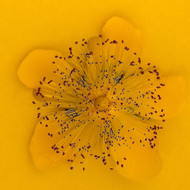St. John’s wort - remedy & magic potion
15th Mar 2021
| With its yellow, star-shaped flowers and five petals St. John’s wort (Hypericum perforatum) is easily noticeable in sunny, temperate, and well-drained areas of Europe, North and South America, Australia, New Zealand, northern Africa, and western Asia. The flowering plant, poisonous to grazing animals, can grow to be 50cm to 1m tall and belongs to the Hypericaceae family which comprises of six to nine genera and up to 700 species. St. John’s wort owes its interesting name to the fact it blooms at the time of the summer solstice on or around St. John’s day on June 24. |
| Like many other plants, the star-shaped flowers of St. John’s wort have been used for different purposes throughout history. As early as the 1st century AD, the Roman military doctor Proscurides used this plant as a remedy. In ancient Greece, St. John's wort was used to treat a wide range of illnesses, including nervous disorders.* The Greek physicians of the 1st century AD Pliny, Galen, Hippocrates, and Dioscorides recommended St. John’s wort as a diuretic, wound-healing herb, treatment for menstrual disorders, cure for intestinal worms and snakebites, and other problems.* |  |
| From its role as a remedy in ancient times, the yellow-flowered plant moved to a different use in Middle Ages when it was added to magic potions. Back then, it was believed that St. John’s wort could protect people and animals from witches, demons, and evil diseases. Besides its use to alleviate insomnia, depression, and other symptoms, St. John’s wort provided protection against everything people in that time considered dangerous.* |
| Although the use of St. John’s wort has varied through centuries, one thing remained certain even in the 21st century – the plant holds significant potential worth exploring. The plant has become a subject of many studies whose primary objective is to evaluate its benefits and mechanisms of action. |
| Nowadays, many herbal supplements contain St. John's wort. The cheerfully yellow flowers are used to make extracts, pills, and teas. Some oil-based skin lotions may also contain St. John’s wort. |
| The herb is used to help manage problems such as depression and anxiety.* St. John’s wort may be effective in treating wounds, burns, bruises, and sores.* The use of a star-shaped flowering plant could relieve the physical and emotional symptoms of PMS in some women, including cramps, irritability, food cravings, and breast tenderness.* In combination with other plants, St. John's wort could bring relief to women in menopause.* |
| The plant is considered safe for general consumption, which is why many dietary supplements contain St. John's worth on their ingredient lists. However, caution is necessary, especially if a person takes medications such as antidepressants. More research is necessary to elucidate the true potential of St. John’s wort and mechanisms of action. Many pharmaceutical companies, especially in Europe, include St. John’s worth in their preparations. The potential of St. John’s wort is also the reason why many men and women who focus on holistic lifestyle use products containing this plant. |
References:
https://www.ncbi.nlm.nih.gov/books/NBK92750/
https://www.britannica.com/plant/Hypericum
https://www.ncbi.nlm.nih.gov/pubmed/11155493
http://pennstatehershey.adam.com/content.aspx?productid=107&pid=33&gid=000276
https://www.healthline.com/health-news/is-st-johns-wort-safe-080615#3

